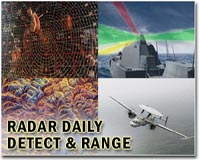 |
Santa Cruz, Calif. (UPI) Nov 26, 2010 Radar guns used by police to spot speeding motorists could help identify suicide bombers by detecting the wiring in an explosive vest, U.S. researchers say. A police radar gun fires pulses at a car and measures the shift of the reflected signal to calculate its velocity, but the strength and polarization of the reflected signal -- the "radar cross section" -- can provide additional information about the size and shape of the reflecting object and the material from which it is made, NewScientist.com reported. Two researchers in California decided to see if the wiring in a suicide vest would alter the radar cross section of a bomber enough to allow a radar gun to pick him or her out in a crowd. William Fox of the Naval Postgraduate School in Monterey, Calif., and John Vesecky of the University of California, Santa Cruz, fired low-power radar pulses at groups of volunteers, some wearing vests wired up like suicide vests. About 85 percent of the time, telltale changes in the reflected signals allowed them to correctly identify a "bomber" up to 30 feet away, they said. The researchers hope to further develop the system, allowing them to improve the detection rate and refine the system to avoid false alarms being triggered by metal in underwire bras, jewelry and earphone leads. The researchers say military checkpoints would be major users of such a system but that it could also be installed alongside closed-circuit cameras in shopping malls, railway stations and airports, NewScientist.com reported.
Share This Article With Planet Earth
Related Links Space Technology News - Applications and Research
 Russia 'gives Iran top new radar'
Russia 'gives Iran top new radar'Beirut, Lebanon (UPI) Nov 22, 2010 Iran recently boasted it was greatly extending its radar capabilities, a vital component in its drive to use its own resources to strengthen its air defenses against U.S. or Israeli attack. But a report by the U.S. global security consultancy Stratfor claimed Saturday that Tehran recently apparently got a big and very discreet helping hand from Russia. No time frame for the assist was g ... read more |
|
| The content herein, unless otherwise known to be public domain, are Copyright 1995-2010 - SpaceDaily. AFP and UPI Wire Stories are copyright Agence France-Presse and United Press International. ESA Portal Reports are copyright European Space Agency. All NASA sourced material is public domain. Additional copyrights may apply in whole or part to other bona fide parties. Advertising does not imply endorsement,agreement or approval of any opinions, statements or information provided by SpaceDaily on any Web page published or hosted by SpaceDaily. Privacy Statement |